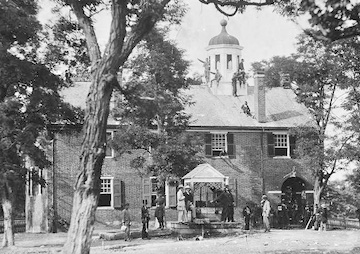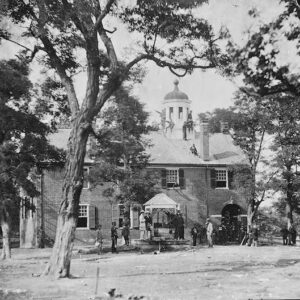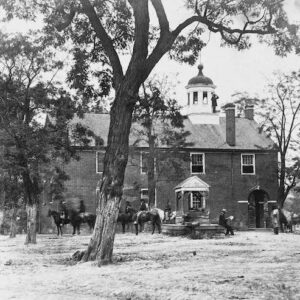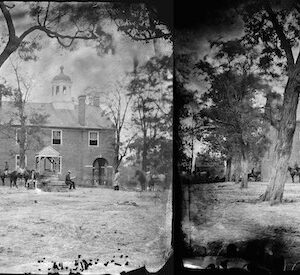Tag: County Courthouse (Fairfax Court House VA)
 Wikipedia says: The former Fairfax County Courthouse is the oldest historic building in Fairfax. The first Fairfax courthouse was established in 1742 near present-day Tysons Corner, and is the namesake for Old Courthouse Road. It intersects with Gallows Road, which today is a major commuter route, but at the time was the road where condemned prisoners were led to the gallows at the old courthouse. In 1752, the courthouse was moved to Alexandria, which offered to build the new courthouse at their own expense. The reason the courthouse was moved from the Tysons Corner location was because of “Indian hostilities”, as noted on the stone marker at the northwest corner of Gallows Road and Route 123. The courthouse operated there until 1790, when Virginia ceded the land where the courthouse was located for the creation of Washington, DC. The General Assembly specified that the new courthouse should be located in the center of the county, and was established at the corner of what was Old Little River Turnpike and is now Main Street and what was Ox Road and is now Chain Bridge Road on land donated by town founder Richard Ratcliffe. The courthouse changed hands repeatedly during the Civil War, and the first Confederate officer battle casualty, John Quincy Marr, occurred on its grounds. The first meeting of the Fairfax Court was held April 21, 1800.
Wikipedia says: The former Fairfax County Courthouse is the oldest historic building in Fairfax. The first Fairfax courthouse was established in 1742 near present-day Tysons Corner, and is the namesake for Old Courthouse Road. It intersects with Gallows Road, which today is a major commuter route, but at the time was the road where condemned prisoners were led to the gallows at the old courthouse. In 1752, the courthouse was moved to Alexandria, which offered to build the new courthouse at their own expense. The reason the courthouse was moved from the Tysons Corner location was because of “Indian hostilities”, as noted on the stone marker at the northwest corner of Gallows Road and Route 123. The courthouse operated there until 1790, when Virginia ceded the land where the courthouse was located for the creation of Washington, DC. The General Assembly specified that the new courthouse should be located in the center of the county, and was established at the corner of what was Old Little River Turnpike and is now Main Street and what was Ox Road and is now Chain Bridge Road on land donated by town founder Richard Ratcliffe. The courthouse changed hands repeatedly during the Civil War, and the first Confederate officer battle casualty, John Quincy Marr, occurred on its grounds. The first meeting of the Fairfax Court was held April 21, 1800.
Gardner’s Photographic Sketch Book Of The War. Vol. 1. No. 3. Fairfax Court-House. June, 1863. The village of Fairfax Court-House, Virginia, eighteen miles from Washington, was, previous to the rebellion, one of the loveliest of the State. Numbering about three thousand inhabitants, with three large hotels, two fine churches, and a flourishing female institute, the place had become of considerable importance at the time of secession, from which it was the first to suffer. Each of the many commands which occupied the town during the war added to the work of devastation commenced in 1861, and long before peace was announced its comeliness had departed. Its best houses were burned, the churches were converted into hospitals, and then into stables, while the venerable Court-House was stripped of its wood-work, leaving only the naked walls and roof. In 1864, loop-holes were cut through the side of the building for riflemen and troops stationed in it to repel any attack that might be made by guerillas who constantly hovered in the vicinity. The records kept here were of great historical interest, dating from the early settlement of Virginia, and including many documents in the writing of George Washington. A great number of these were carried off by curiosity hunters in the sacking which took place in September, 1862, and a still greater number were ruthlessly destroyed by the soldiery. Generals McClellan and Hooker each temporarily had their headquarters here when in command of the Army of the Potomac, as did also the lamented Sumner, and other officers of equal rank. The battle-field of Bull Run is ten limes distant, and Chantilly, where the gallant Kearney adn Stephens fell, but five miles away.
Showing all 3 results


